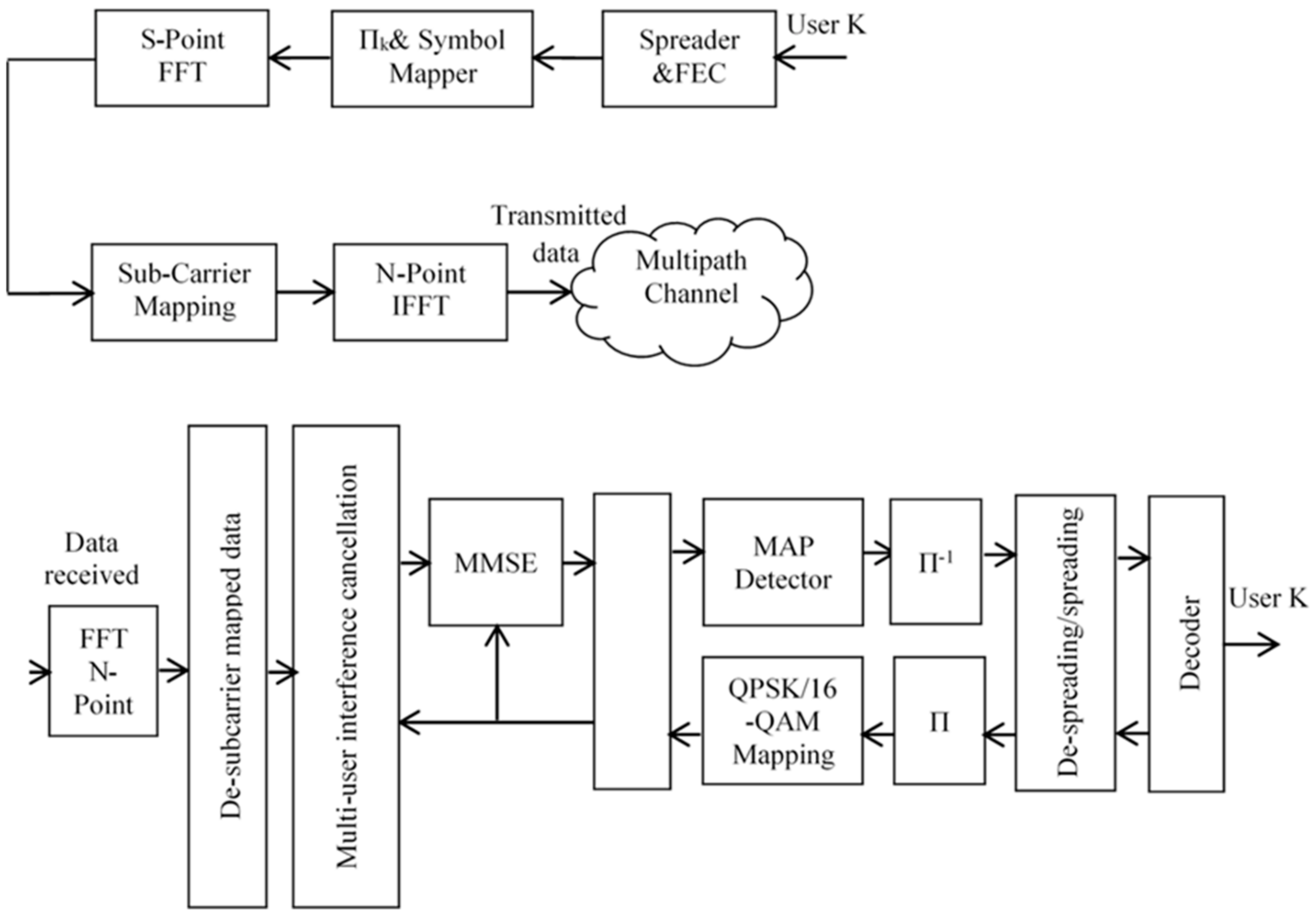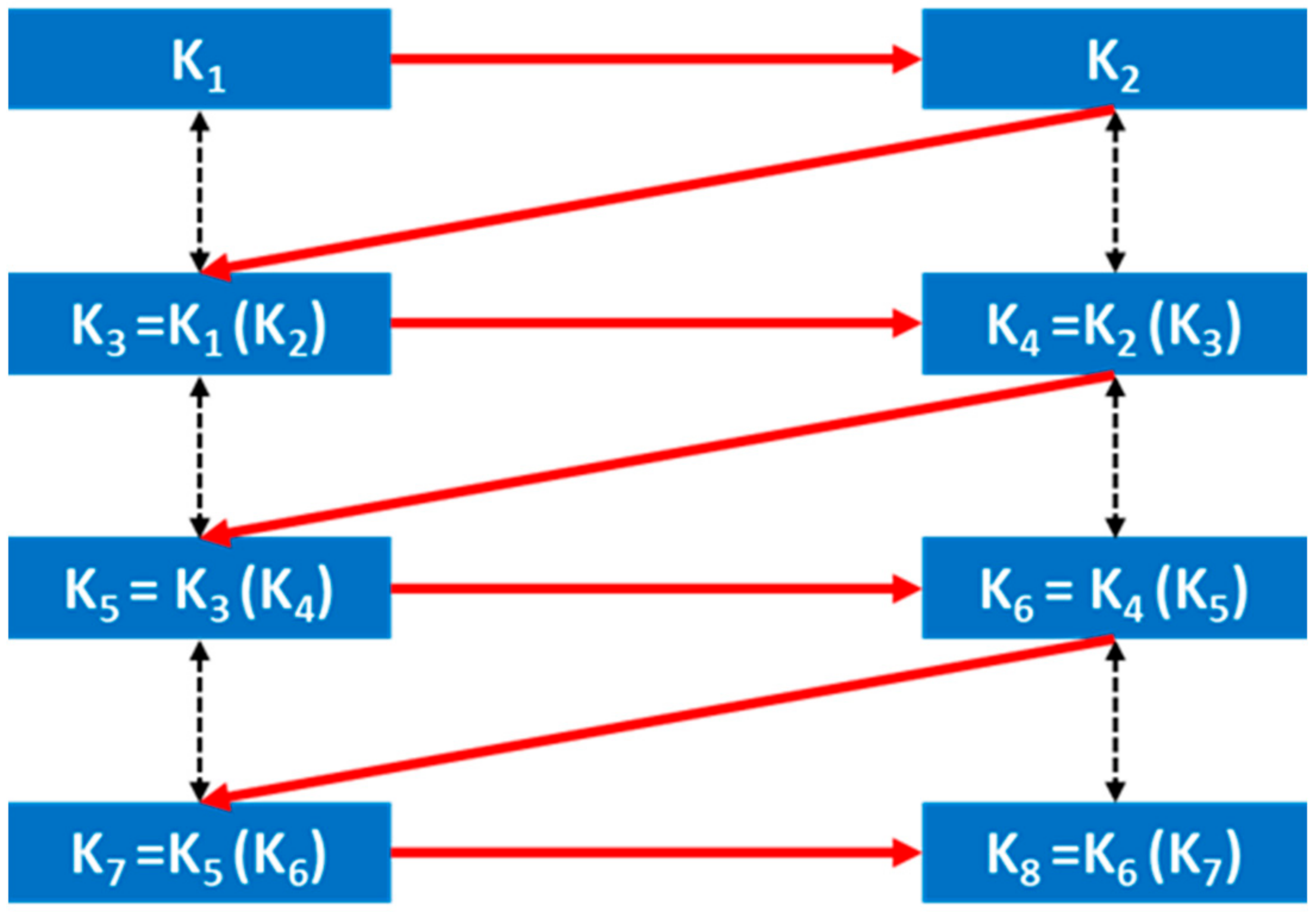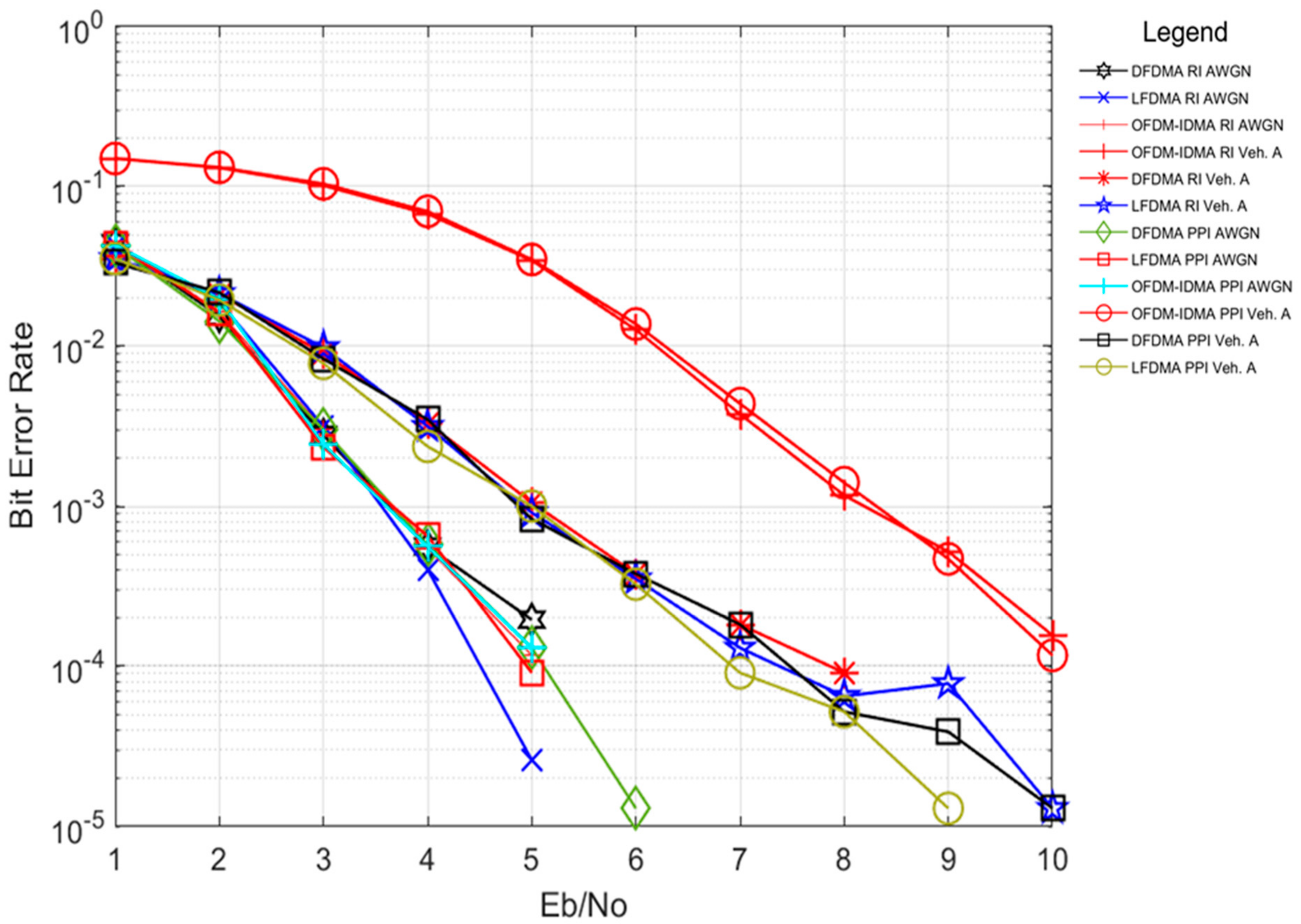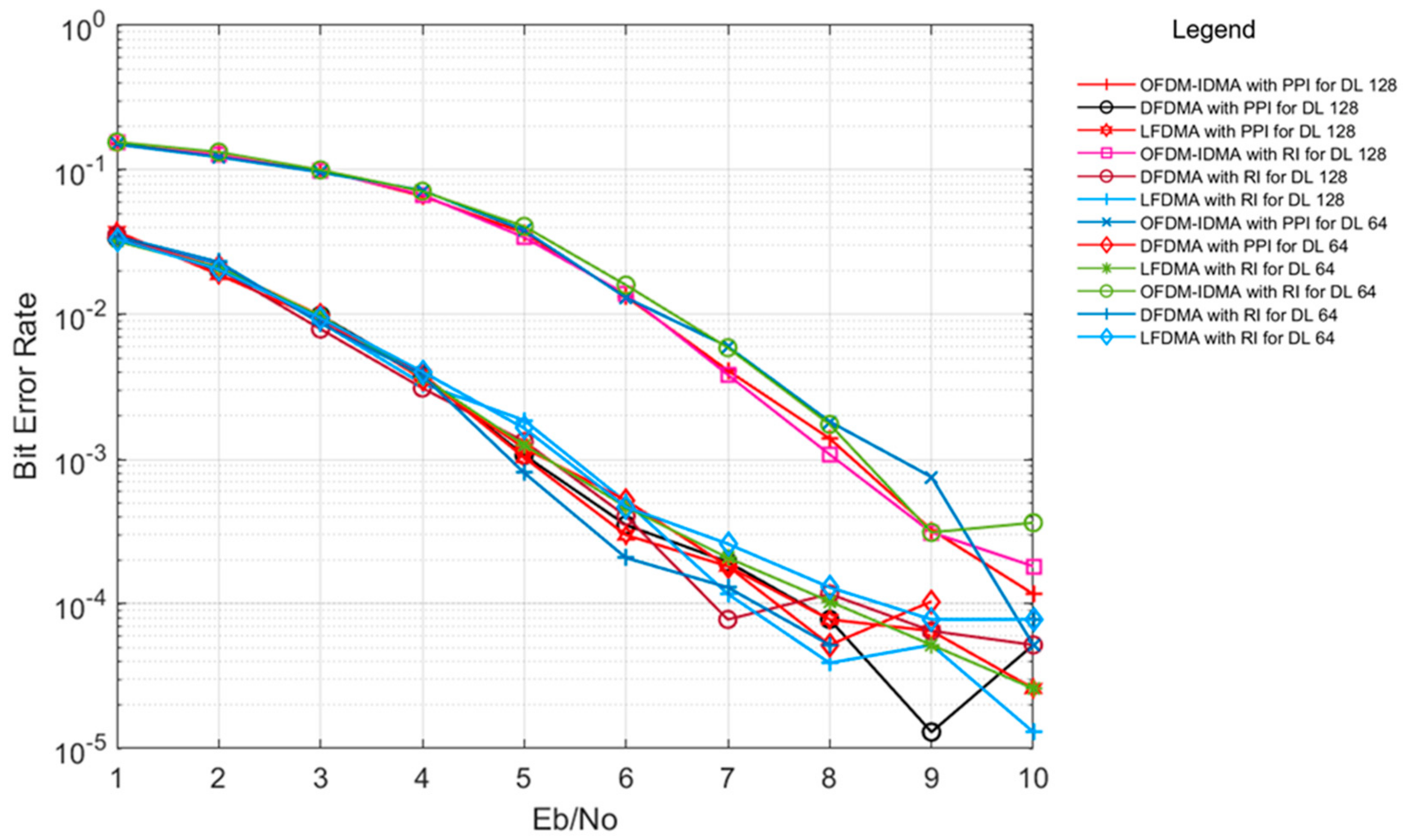Progressive Pattern Interleaver with Multi-Carrier Modulation Schemes and Iterative Multi-User Detection in IoT 6G Environments with Multipath Channels
Abstract
1. Introduction
2. Related Work
- Improved user identification: By utilizing techniques like progressive pattern interleaver (PPI), our study enhances the ability to identify users in congested network environments. This is crucial for ensuring efficient and reliable communication in future networks.
- Enhanced performance in fading channels: Our study demonstrates that NOMA schemes, when combined with PPI and multi-carrier modulation techniques like SC-FDMA-IDMA and OFDM-IDMA, can significantly improve performance in fading channels. This is essential for maintaining stable and high-quality communication in wireless environments.
- Optimized multi-carrier modulation: The optimization of multi-carrier modulation is key to maximizing spectral efficiency and network capacity. Our analysis of multi-carrier NOMA schemes with PPI provides insights into how these techniques can be optimized for future networks.
- Reduced implementation complexity: Simplifying the implementation of NOMA schemes, particularly with the use of techniques like PPI, can lead to reduced implementation complexity. This is important for ensuring the practicality and efficiency of wireless communication systems.
3. System Model
3.1. Transmitter Structure
3.2. PPI Interleaver Mechanism
- a.
- Sequence of base station interleaving pattern generation
- b.
- Sequence of mobile station interleaving pattern generation
- c.
- Interleaving pattern generation during the implementation of MUD
3.3. Channel Considerations
3.4. Receiver Structure
4. Simulation Parameters and Results
5. Conclusions and Future Works
Author Contributions
Funding
Institutional Review Board Statement
Informed Consent Statement
Data Availability Statement
Conflicts of Interest
References
- Dai, L.; Wang, B.; Ding, Z.; Wang, Z.; Chen, S.; Hanzo, L. A Survey of Non-Orthogonal Multiple Access for 5G. IEEE Commun. Surv. Tutor. 2018, 20, 2294–2323. [Google Scholar] [CrossRef]
- Osseiran, A.; Boccardi, F.; Braun, V.; Kusume, K.; Marsch, P.; Maternia, M.; Queseth, O.; Schellmann, M.; Schotten, H.; Taoka, H.; et al. Scenarios for 5G mobile and wireless communications: The vision of the METIS project. IEEE Commun. Mag. 2014, 52, 26–35. [Google Scholar] [CrossRef]
- Hamad, Y.; Ashfaq, A.; Emad, A.; Arafat, A. Error Rate Analysis of NOMA: Principles, Survey and Future Directions. IEEE Open J. Commun. Soc. 2022, 4, 1682–1727. [Google Scholar] [CrossRef]
- Makki, B.; Chitti, K.; Behravan, A.; Alouini, M.S. A Survey of NOMA: Current Status and Open Research Challenges. IEEE Open J. Commun. Soc. 2020, 1, 179–189. [Google Scholar] [CrossRef]
- Wang, P.; Xiao, J.; Ping, L. Comparison of Orthogonal and Non-Orthogonal Approaches to Future Wireless Cellular Systems. IEEE Veh. Technol. Mag. 2006, 1, 4–11. [Google Scholar] [CrossRef]
- Andrews, J.G. Interference cancellation for cellular systems: A contemporary overview. IEEE Trans. Wirel. Commun. 2005, 12, 19–29. [Google Scholar] [CrossRef]
- Liberti, J.C.; Rappaport, T.S. Smart Antennas for Wireless Communications: IS-95 and Third Generation CDMA Applications, Prentice Hall Communications Engineering and Emerging Technologies Series; Prentice Hall: Upper Saddle River, NJ, USA, 1999. [Google Scholar]
- Wang, X.; Poor, H.V. Iterative (Turbo) Soft interference Cancellation and Decoding for Coded CDMA. IEEE Trans. Commun. 1999, 47, 1046–1061. [Google Scholar] [CrossRef]
- Kusume, K.; Bauch, G. CDMA and IDMA: Iterative Multiuser Detections for Near-Far Asynchronous Communications. In Proceedings of the IEEE International Symposium on Personal, Indoor and Mobile Radio Communication (PIMRC’05), Berlin, German, 11–14 September 2005; pp. 426–431. [Google Scholar] [CrossRef]
- Liu, L.; Tong, J.; Ping, L. Analysis and optimization of CDMA Systems with Chip-Level Interleavers. IEEE JSAC 2006, 24, 141–150. [Google Scholar] [CrossRef][Green Version]
- Ping, L.; Liu, L.; Wu, K.Y.; Leung, W.K. Interleave-division multiple-access. IEEE Trans. Wirel. Commun. 2006, 5, 938–947. [Google Scholar] [CrossRef]
- Aliesawi, S.A.; Tsimenidis, C.C.; Sharif, B.S.; Johnston, M. Iterative Multiuser Detection for Underwater Acoustic Channel. IEEE J. Ocean. Eng. 2011, 36, 728–744. [Google Scholar] [CrossRef]
- Singer, A.C.; Nelson, J.K.; Kozat, S.S. Signal Processing for Underwater Acoustic Communications. IEEE Commun. Mag. 2009, 47, 90–96. [Google Scholar] [CrossRef]
- Chronopoulos, S.K. Flexible and Reconfigurable OFDM Implementation in DSP Platform for Various Purposes and Applications. Sensors 2024, 24, 2732. [Google Scholar] [CrossRef]
- Yin, H.; Alamouti, S. OFDMA: A Broadband Wireless Access Technology. In Proceedings of the IEEE Sarnoff Symposium, Princeton, NJ, USA, 27–28 March 2006; pp. 1–4. [Google Scholar] [CrossRef]
- Myung, H.G.; Lim, J.; Goodman, D. Peak-to-average power ratio of single carrier FDMA signals with pulse shaping. In Proceedings of the IEEE PIMRC, Helsinki, Finland, 11–14 September 2006; pp. 1–5. [Google Scholar] [CrossRef]
- Jiang, T.; Wu, Y. An Overview: Peak-to-average power ratio reduction techniques for OFDM signals. IEEE Trans. Broadcast 2008, 54, 257–268. [Google Scholar] [CrossRef]
- Ping, L.; Guo, Q.; Tong, J. The OFDM-IDMA approach to wireless communications. IEEE Wirel. Commun. Syst. 2007, 14, 19–24. [Google Scholar] [CrossRef]
- Choi, C.H.; Lim, H.J.; Kim, T.K.; Im, G.H.; Lawrence, V.B. Spectral Efficient Multiuser Technique with Channel-Dependent Resource Allocation Schemes. IEEE Trans. Wirel. Commun. 2012, 11, 990–999. [Google Scholar] [CrossRef]
- Lim, J.B.; Choi, C.H.; Yune, T.W.; Im, G.H. Iterative Multiuser Detection for Single-Carrier Modulation with Frequency-Domain-Equalization. IEEE Commun. Lett. 2007, 11, 471–473. [Google Scholar] [CrossRef]
- Yune, T.W.; Choi, C.H.; Im, J.H.; Lim, J.B.; Kim, E.S.; Cheong, Y.C.; Kim, K.H. SC-FDMA with iterative multiuser detection: Improvements on power/spectral efficiency. IEEE Commun. Mag. 2010, 48, 164–171. [Google Scholar] [CrossRef]
- Yu, L.; Liu, Z.; Wen, M.; Cai, D.; Dang, S.; Wang, Y.; Xiao, P. Sparse Code Multiple Access for 6G Wireless Communication Networks: Recent Advances and Future Directions. IEEE Commun. Stand. Mag. 2021, 5, 92–99. [Google Scholar] [CrossRef]
- Shah, A.S.; Qasim, A.N.; Karabulut, M.A.; Ilhan, H.; Islam, M.B. Survey and performance evaluation of multiple access schemes for next-generation wireless communication systems. IEEE Access 2021, 9, 113428–113442. [Google Scholar] [CrossRef]
- Singha, P.R.; Singha, V.K.; Yadav, R.; Chaurasia, S.N. 6G networks for artificial intelligence-enabled smart cities applications: A scoping review. Telemat. Inform. Rep. 2023, 9, 100044. [Google Scholar] [CrossRef]
- Dixit, S.; Srivastava, S.; Shukla, M. Design and Analysis of Numerical Interleaver for IDMA schemes with Iterative Multiuser Detection. Indian J. Sci. Technol. 2017, 10, 1–10. [Google Scholar] [CrossRef]
- Dixit, S.; Shukla, V.; Shukla, M. Progressive pattern orthogonal interleaver set for interleave division multiple access based, non orthogonal multiple access schemes: Beyond 5G perspective. J. Electr. Eng. 2022, 73, 419–425. [Google Scholar] [CrossRef]
- Shukla, M.; Srivastava, V.K.; Tiwari, S. Analysis and Design of Optimum Interleaver for Iterative Receivers in IDMA Scheme. Wiley J. Wirel. Commun. Mob. Comput. 2009, 9, 1312–1317. [Google Scholar] [CrossRef]
- Liu, Y.; Yi, W.; Ding, Z.; Liu, X.; Dobre, O.; Al-Dhahir, N. Application of NOMA in 6G networks: Future vision and research opportunities for next generation multiple access. arXiv 2021, arXiv:2103.02334. [Google Scholar]
- Liu, Y.; Zhang, S.; Mu, X.; Ding, Z.; Schober, R.; Al-Dhahir, N.; Hossain, E.; Shen, X. Evolution of NOMA toward next generation multiple access (NGMA) for 6G. IEEE J. Sel. Areas Commun. 2022, 40, 1037–1071. [Google Scholar] [CrossRef]
- Liu, X.; Lam, K.Y.; Li, F.; Zhao, J.; Wang, L.; Durrani, T.S. Spectrum sharing for 6G integrated satellite-terrestrial communication networks based on NOMA and CR. IEEE Netw. 2021, 35, 28–34. [Google Scholar] [CrossRef]
- Raj, R.; Dixit, A. An energy-efficient power allocation scheme for NOMA-based IoT sensor networks in 6G. IEEE Sens. J. 2022, 22, 7371–7384. [Google Scholar] [CrossRef]
- Ihsan, A.; Chen, W.; Asif, M.; Khan, W.U.; Wu, Q.; Li, J. Energy-efficient IRS-aided NOMA beamforming for 6G wireless communications. IEEE Trans. Green Commun. Netw. 2022, 6, 1945–1956. [Google Scholar] [CrossRef]
- Jiang, H.; Mukherjee, M.; Zhou, J.; Lloret, J. Channel modeling and characteristics for 6G wireless communications. IEEE Netw. 2020, 35, 296–303. [Google Scholar] [CrossRef]
- Thet, N.W.M.; Khan, S.; Arvas, E.; Özdemir, M.K. Impact of mutual coupling on power-domain non-orthogonal multiple access (NOMA). IEEE Access 2020, 8, 188401–188414. [Google Scholar] [CrossRef]
- Wang, L.; Xu, L.; Tian, W.; Zhang, Y.; Feng, H.; Chen, Z. Underwater image super-resolution and enhancement via progressive frequency-interleaved network. J. Vis. Commun. Image Represent. 2022, 86, 103545. [Google Scholar] [CrossRef]
- Shahab, M.B.; Abbas, R.; Shirvanimoghaddam, M.; Johnson, S.J. Grant-free non-orthogonal multiple access for IoT: A survey. IEEE Commun. Surv. Tutor. 2020, 22, 1805–1838. [Google Scholar] [CrossRef]
- Abbas, R. VLC systems using NOMA techniques: An overview. Phys. Commun. 2023, 60, 102144. [Google Scholar] [CrossRef]
- Chronopoulos, S.K.; Christofilakis, V.; Tatsis, G.; Kostarakis, P. Performance of Turbo Coded OFDM Under the Presence of Various Noise Types. Wirel. Pers. Commun. 2016, 87, 1319–1336. [Google Scholar] [CrossRef]
- Wu, H.; Ping, L. PerottiA User-specific chip-level interleaver design for IDMA systems. Electron. Lett. 2006, 42, 233–234. [Google Scholar] [CrossRef]
- Myung, H.G.; Goodman, D.J. Single Carrier FDMA: A New Air Interface for Long Term Evolution; Wiley Series on Wireless Communications and Mobile Computing; Wiley: New York, NY, USA, 2008; ISBN 978-0-470-75870-0. [Google Scholar]
- Rana, M.M.; Kim, J.; Cho, W.K. Performance analysis of subcarrier mapping in LTE uplink systems. In Proceedings of the 9th International Conference on Optical Internet, Jeju, Republic of Korea, 11–14 July 2010; pp. 1–3. [Google Scholar] [CrossRef]
- 3rd Generation Partnership Project, 3GPP TS 25.101. Technical Specification Group Radio Access Network. In User Equipment (UE) Radio Transmission and Reception (FDD) (Release 7); 3GPP: Valbonne, France, 2007; Section B.2.2. [Google Scholar]
- The MathWorks, Inc. Optimization Toolbox Version: 9.4 (R2022b). 2022. Available online: https://www.mathworks.com (accessed on 31 May 2024).






| Channel Delay Profiles | Path-1 (Direct) | Path-2 | Path-3 | Path-4 | Path-5 | Path 6 |
|---|---|---|---|---|---|---|
| Delay (in n-sec) | 0 | 310 | 710 | 1090 | 1730 | 2510 |
| Power (in dB) | 0 | −1.0 | −9.0 | −10.0 | −15.0 | −20.0 |
Disclaimer/Publisher’s Note: The statements, opinions and data contained in all publications are solely those of the individual author(s) and contributor(s) and not of MDPI and/or the editor(s). MDPI and/or the editor(s) disclaim responsibility for any injury to people or property resulting from any ideas, methods, instructions or products referred to in the content. |
© 2024 by the authors. Licensee MDPI, Basel, Switzerland. This article is an open access article distributed under the terms and conditions of the Creative Commons Attribution (CC BY) license (https://creativecommons.org/licenses/by/4.0/).
Share and Cite
Dixit, S.; Shukla, V.; Misra, M.K.; Jimenez, J.M.; Lloret, J. Progressive Pattern Interleaver with Multi-Carrier Modulation Schemes and Iterative Multi-User Detection in IoT 6G Environments with Multipath Channels. Sensors 2024, 24, 3648. https://doi.org/10.3390/s24113648
Dixit S, Shukla V, Misra MK, Jimenez JM, Lloret J. Progressive Pattern Interleaver with Multi-Carrier Modulation Schemes and Iterative Multi-User Detection in IoT 6G Environments with Multipath Channels. Sensors. 2024; 24(11):3648. https://doi.org/10.3390/s24113648
Chicago/Turabian StyleDixit, Shivani, Varun Shukla, Manoj Kumar Misra, Jose M. Jimenez, and Jaime Lloret. 2024. "Progressive Pattern Interleaver with Multi-Carrier Modulation Schemes and Iterative Multi-User Detection in IoT 6G Environments with Multipath Channels" Sensors 24, no. 11: 3648. https://doi.org/10.3390/s24113648
APA StyleDixit, S., Shukla, V., Misra, M. K., Jimenez, J. M., & Lloret, J. (2024). Progressive Pattern Interleaver with Multi-Carrier Modulation Schemes and Iterative Multi-User Detection in IoT 6G Environments with Multipath Channels. Sensors, 24(11), 3648. https://doi.org/10.3390/s24113648










